
The longest beach in Texas is 70 miles of splendor on Padre Island, located along Texas’s southern coast, on the Gulf of Mexico. However, not only is it the longest beach in Texas, but it’s also one of the longest beaches in the world. The sandy beaches of Padre Island have a rich history and are home to a diverse range of wildlife. Keep reading to learn more about what makes it a special destination.
The History of Padre Island
The history of Padre Island begins along North and South Padre Island. Altogether, Padre Island is 113 miles long, extending from Corpus Christi to Port Isabel. However, North and South Padre are separated by 100 miles because of the Port Mansfield Channel.
Padre Island was originally named Isla Blanca by the Spanish Explorer Alonso Alvarez de Pineda, who first visited the island in 1519. However, the name was later changed for the Spanish priest, Padre Jose Nicolas Balli, who created the first permanent settlement on the island. Until the seashore opened in 1962, it was primarily used for ranching. Now, the central portion of the national seashore makes up 70 miles of splendor and the longest beach in Texas.
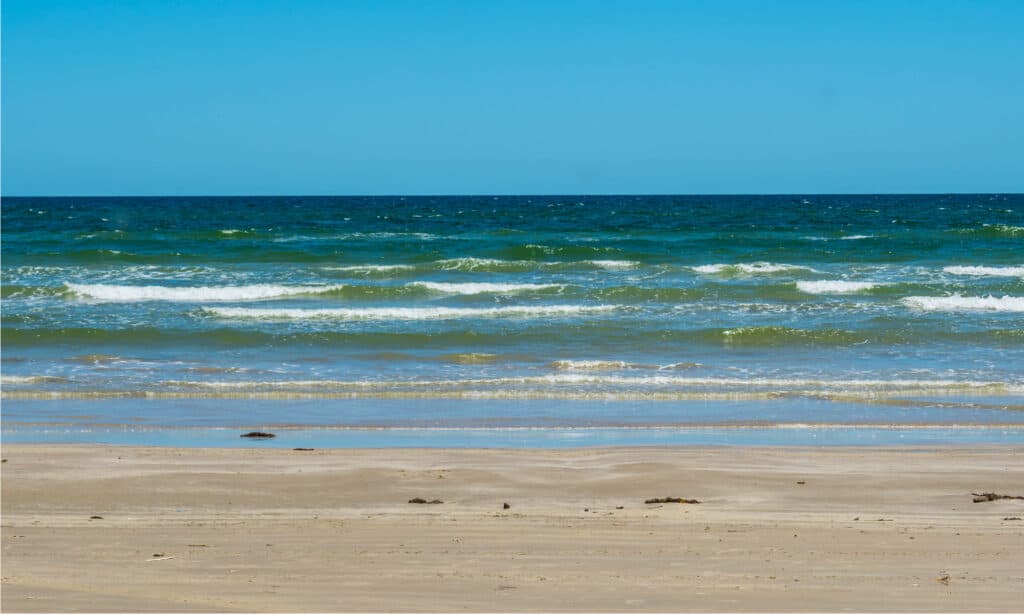
Padre Island National Seashore is dedicated to wildlife conservation.
©Cheri Alguire/Shutterstock.com
Geology and Geography
Walking along Padre Island National Seashore is like stepping into the past because only the northernmost region is inhabited, making it the longest uninhabited barrier in the U.S.
Padre Island formed as a submerged sandbar roughly 4,000 years ago. But geologically, it’s a relatively young island. The natural barriers that makeup Padre Island protect the mainland from storms that brew in the Gulf of Mexico. A unique feature of the island is the display of the life sequence of barrier shorelines. Shifted land and erosion from storm breaches, sand, and wind slowly created short islands that later joined to form longer islands in the region.
North Padre Island winds create longshore currents and feature gulf waves that break against the shore, especially during fall and winter. This consistent water agitation causes the sand to erode while flat, smooth, and symmetrical waves move the sand to different areas. In some areas, native plants stabilize the sand, creating a dune range. The sandy beaches, dunes, grasslands, and tidal flats are reshaped daily – a powerful reminder of the fragility of coastal ecosystems.
Flora and Fauna
The longest beach in Texas is sprawling with native plants and animals protected by the Padre Island National Seashore, giving visitors a glimpse of the primarily undisturbed environment. Most animals found here are commonly associated with grasslands or the seashore. However, the unique tidal mud flats along Laguna Madre and the narrow barrier island are home to one of the last intact coastal prairie habitats, making the wildlife much more special.
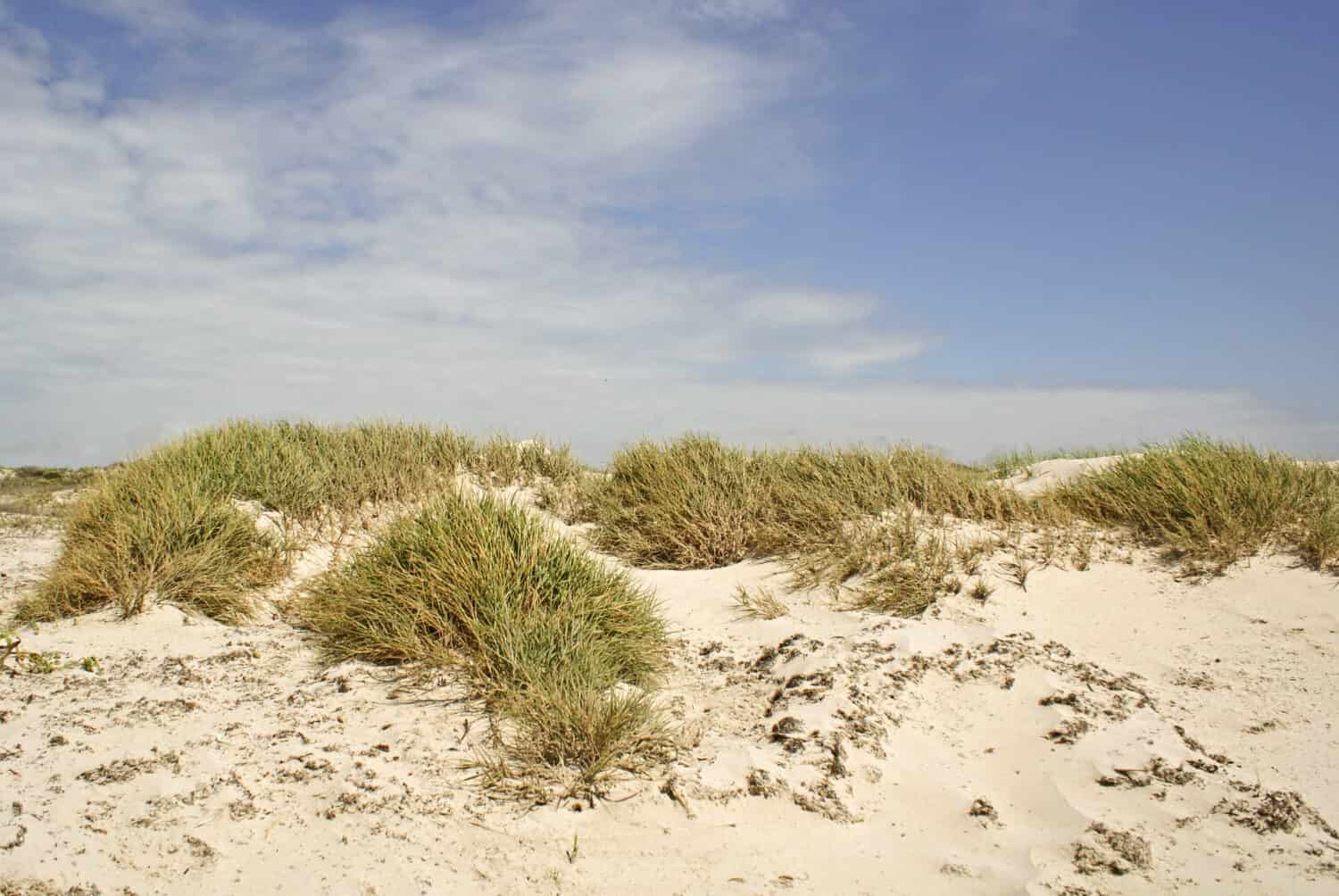
Padre Island features several different habitats.
©StompingGirl/Shutterstock.com
Climate Overview by Season
The general climate on the longest beach in Texas is subtropical, with hot and humid summers and mild winters. The island’s subtropical climate and quickly changing weather make it possible for a wide range of plants and animals to survive along the coast. However, it makes planning a trip to the beach a lot harder, especially during the hurricane season that lasts from June 1 to November 30. Year-round humidity rarely drops lower than 70%.
Spring
Spring on Padre Island is relatively mild. Daily average temperatures range between 70-80 degrees Fahrenheit. But low temperatures dip into the 50s and 60s overnight and on cooler spring days.
Summer
Summers are characterized by daily high temperatures that stay in the mid-90s with high humidity. On the other hand, low temperatures hover around the 70s. The coolest time is in the late afternoon and evening because the sea breeze moderates the temperature.
Fall
Fall temperatures resemble those in spring. Daily average temperatures range from 70-80 degrees Fahrenheit with low temperatures hovering between 50-60 degrees Fahrenheit.
Winter
Winter on Padre Island offers the mildest temperatures. High temperatures are typically between 50-70 degrees Fahrenheit but can drop to the upper 30s when cold fronts cross the shore. These gale-force winds cause temperatures to drop quickly.
The Best Time to Visit
Padre Island can be visited year-round, but the best time to visit the longest beach in Texas will vary according to your favorite activities. The best months to see the Padre Island National Seashore area are May, June, August, and October if you want to experience the best beach weather. These months provide the most sunshine and the lowest chance of rain. If you’re interested in sunbathing and want to feel the hot sun on your skin, April to October provides the highest temperatures. Furthermore, May and October are the best months for swimming because the sea temperatures are over 75 degrees Fahrenheit, perfect temperatures for a pleasant swim.
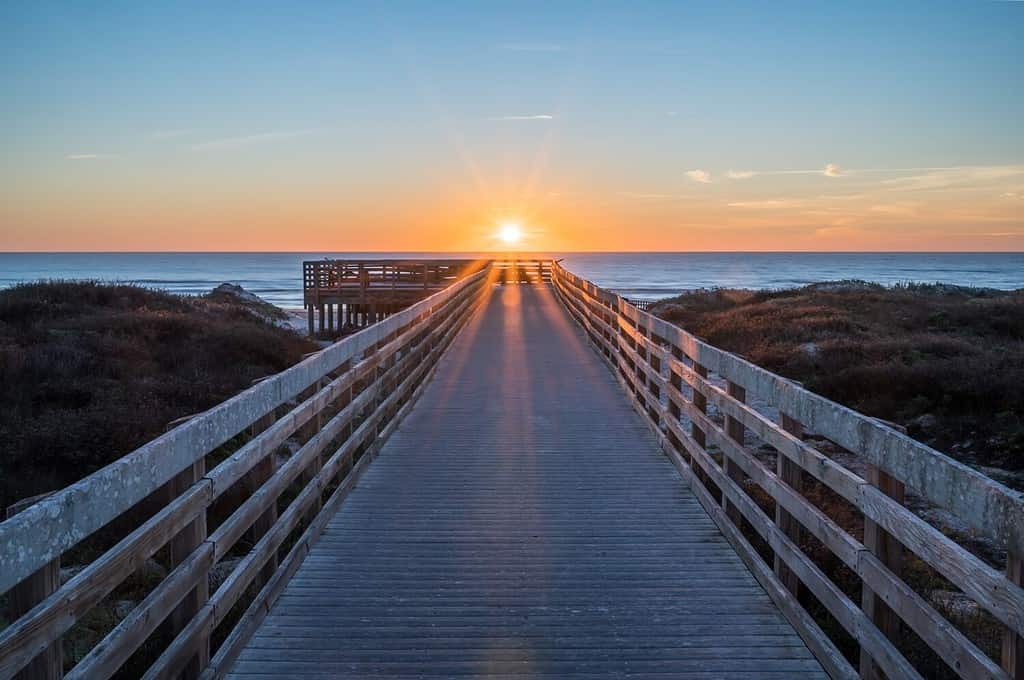
Watching the beautiful sunrise and sunset on Padre Island are the most popular activities.
©Tim Malek/Shutterstock.com
Things to Do Near Padre Island
Padre Island offers a mix of recreational and commercial activities to support the island and give visitors the experience of a lifetime. The subtropical climate and warm waters of the Gulf of Mexico offer beachgoers and nature enthusiasts an ideal spot for baking in the sun, swimming, and learning more about native coastal Texas wildlife.
Walk Along the Padre Island National Seashore
The Padre Island National Seashore protects over 66 miles of the Gulf of Mexico coastline. The preserved and pristine park is mostly primitive, but camping is available in some regions. Most of the beach is only accessible using four-wheel-drive vehicles but four miles of the land is open to vehicle traffic. Laguna Madre, which is west of the coast, is a popular windsurfing spot.
Relax at Whitecap Beach
Whitecap Beach is named for the beautiful sands of its untouched shore. This is the ideal spot for small groups, solo travelers, and anyone looking to get away from the busy beach scene of South Padre Island. Here, visitors can enjoy the mile-long Padre Island Seawall, which protects the hotels and resorts with a sand-free path for walking, jogging, or biking down the beach.
Eat at Sunset Island
Sunset Island looks over Laguna Madre, offering visitors delicious seafood, local crafts, and fun for everyone. Two of the most popular restaurants on Sunset Island are Snoopy’s and Scoopy’s. There are also 600 feet of boardwalk covered in artwork to walk along. But the best part about visiting Sunset Island is watching the beautiful sunset on the horizon at the end of a busy day on Padre Island.
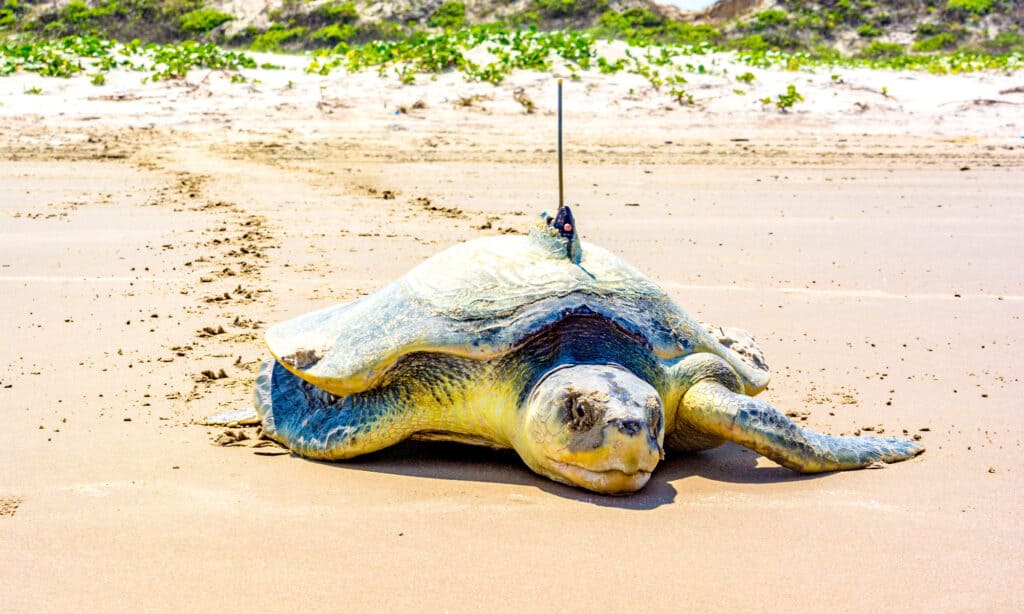
Kemp’s ridley sea turtles are the smallest turtle on Padre Island and in the world.
©JB Manning/Shutterstock.com
Animals Found on Padre Island
It’s no surprise that Padre Island, the longest beach in Texas, is home to many habitat types and a broad spectrum of animals. From the Gulf of Mexico to the shores of Laguna Madre, hundreds of creatures live together. Below are some of the most interesting animals found here.
Sooty Tern (Onychoprion fuscatus)
Throughout the year, as many as 350 species of birds may inhabit Padre Island. But the sooty tern is one of two unusual and rare species that call the coastal beach home for part of their migration. The sooty tern is a long-winged flier that nests in remote islands and inhabits marshes and shores. They have a distinct black back, black head, and white forehead.
Padre Island Kangaroo Rat (Dipodomys compactus)
Also known as the Gulf Coast kangaroo rat, this rodent species is found in Mexico and Texas. These rats are not often seen because they are primarily nocturnal, spending most of their time in burrows. They mainly eat seeds and insects, carrying leftovers in their cheek pockets for later. This species rarely drinks water, and they have long hind legs to jump. You might be lucky and see their tracks in the sand!
Kemp’s Ridley Sea Turtle (Lepidochelys kempii)
Kemp’s ridleys are the world’s smallest and most critically endangered sea turtle species. They grow to only about 2 feet in length and are named after the Key West fisherman Richard M. Kemp, who was the first person to submit the species for identification in 1906. What makes them so unique are their nesting habits. Unlike other sea turtle species, they nest during the day in groups called “arribadas.”
Ghost Crab (Ocypode)
Also known as sand crabs, these crustaceans easily blend in with the sandy beaches and dunes they inhabit. They have six strong legs that can carry their bodies as fast as 10 miles per hour. During the day, they spend most of their time digging burrows the size of golf balls in the sand that extend more than 4 feet into the ground. Their eyes allow them to look 360 degrees simultaneously, yet they cannot see directly overhead.
Blue Button Jelly (Porpita porpita)
The blue button jellyfish looks like a jellyfish and has a similar sting but is, in fact, a colony of tiny animals called hydrozoan polyps. These small, blue tentacled creatures dot the beaches like lost coins. They are interesting to look at but should not be touched. Although they are not poisonous, contact can cause skin irritations.
Plants Found on Padre Island
The longest beach in Texas is also home to over 400 different plant species. Below are just a few of the plant varieties to see as you walk along Padre Island.
Padre Island Mistflower (Conoclinium coelestinum)
The mistflower is one of the most important sources for butterflies and moths living on Padre Island. For instance, it’s the only larval food plant for the rounded metalmark in the area. Due to its importance, it is one of the most popular plants in local butterfly gardens, ponds, marshes, and undisturbed areas.
Gulf Dune Paspalum (Paspalum monostachyum)
The Gulf dune paspalum grows to be around 1-2 feet tall with 3 feet tall flowers. They spread from underground to form large patches in the prairie regions of Padre Island. This plant is green and requires full sun to thrive. They also provide food for some of the birds that inhabit the beaches.
Seashore Dropseed (Sporobolus virginicus)
Seashore dropseed grows up to 1-2 feet tall and quickly spreads to form colonies along the beach. They provide winter food to native seabirds who also use their stalks to build nests. They are primarily green with blooms that include spikelets that are green and white or sometimes purple.
White Stem Wild Indigo (Baptisia bracteata)
The white stem wild indigo is a spreading legume with white flowers that grow on horizontal spikes. Their branches are wooly and dropping. They are one of the common forbs that grow in the grasslands or low coastal sands of the beach.
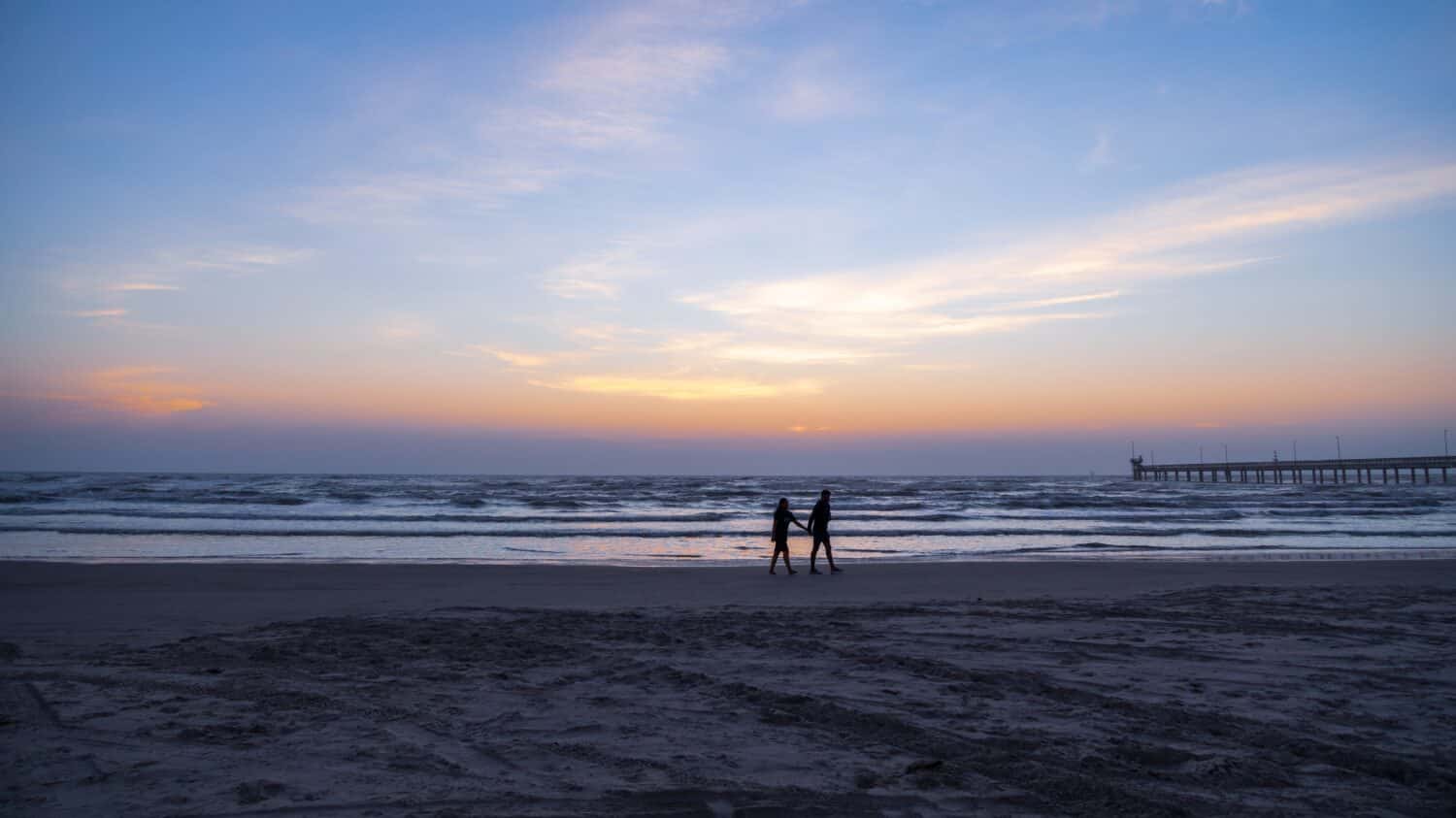
Visitors to Padre Island enjoy walking on the beach, swimming, and watching the sunrise.
©Berns Images/Shutterstock.com
Visiting the Longest Beach in Texas
If visiting the longest beach in Texas is on your bucket list, then come to Padre Island. The north portion of the beach spans 70 miles with over 66 miles dedicated to coastal wildlife preservation. This Texas gem is sprawling with unique plants, animals, and geologic features that make it one of the most beautiful places in the state to visit.
Where Is Padre Island Located on a Map?
The second-longest island in the United States after New York’s Long Island, Padre Island extends from Corpus Christi, Texas, curving along the Texas coast, to almost the border with Mexico. The southernmost part of the island has the community of South Padre. The island is framed by the Gulf of Mexico on the east side and the Laguna Madre on the west.
The town of South Padre Island is located on its southern end, with the city of Corpus Christi situated at the northern end, but the island as a whole is sparsely populated.
The photo featured at the top of this post is © Cheri Alguire/Shutterstock.com
Thank you for reading! Have some feedback for us? Contact the AZ Animals editorial team.






